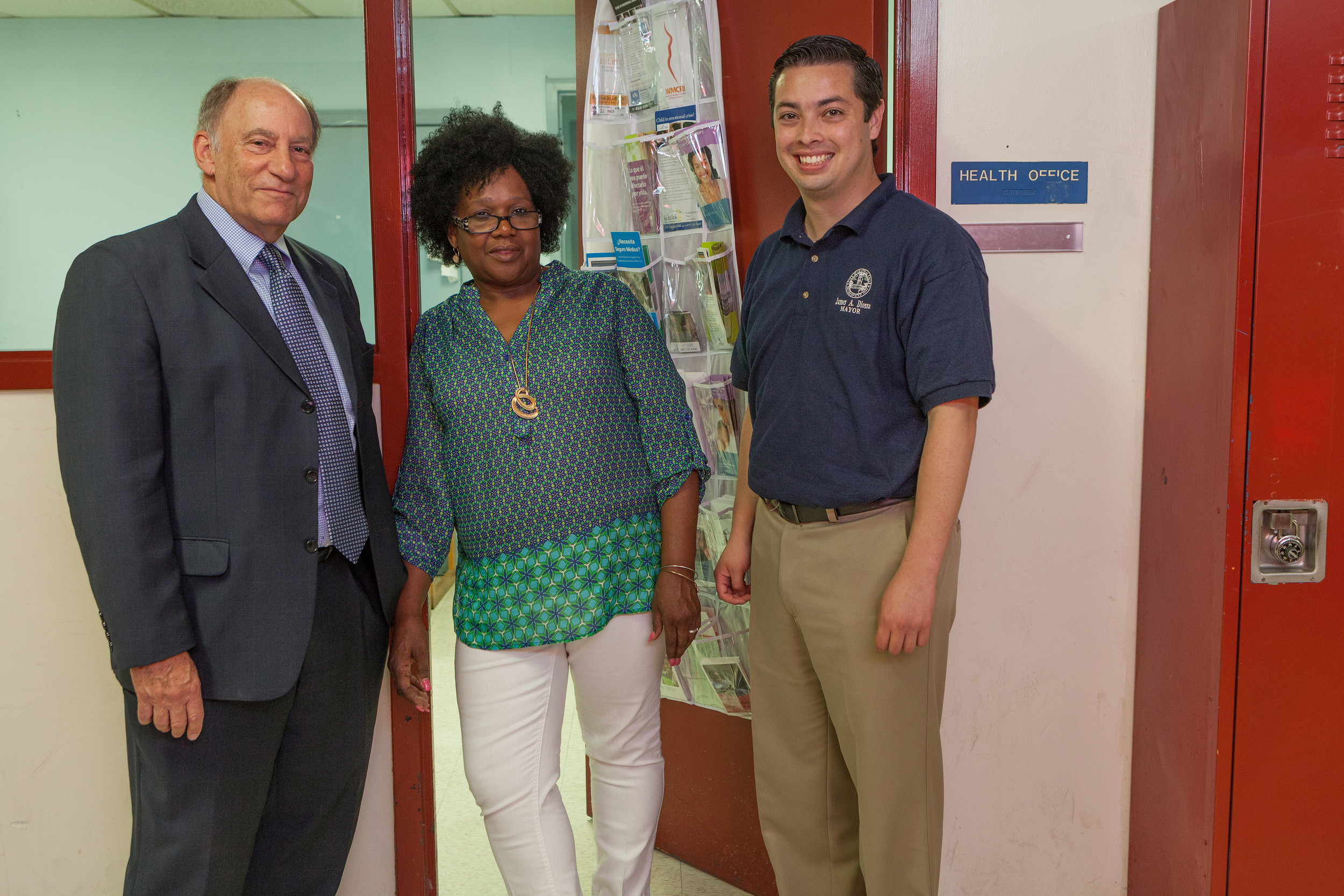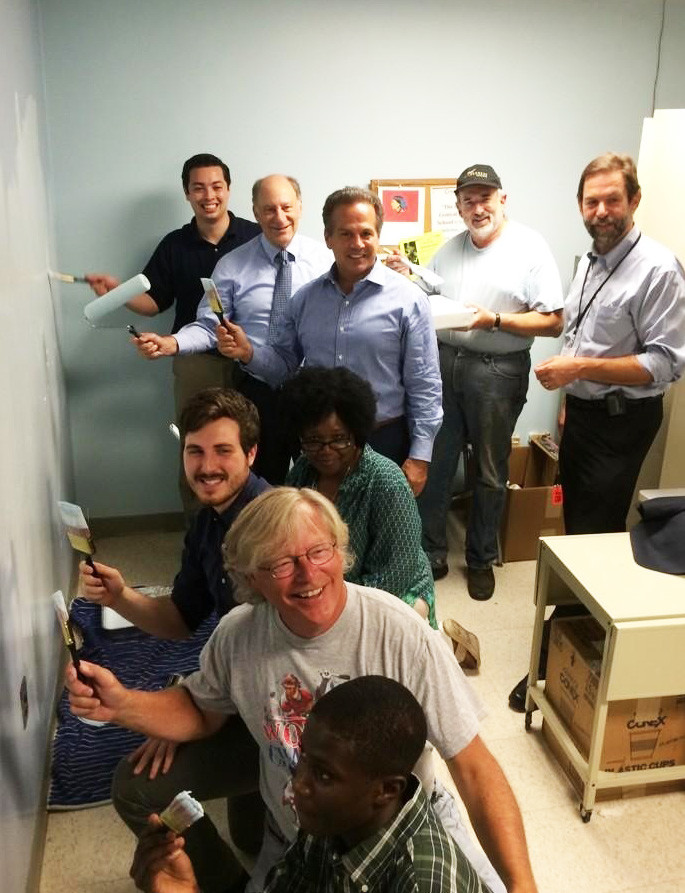A healthy future grows in Central Falls
The square-mile city takes big step toward creation of Rhode Island’s first Neighborhood Health Station
The new Neighborhood Health Station in Central Falls is a long-term investment in the future of city with 19,000 residents; Central Falls is a true comeback story.
These innovation ecosystems, grounded in neighborhoods and communities, need to be fully integrated and connected within the larger, more accepted spheres of Rhode Island’s knowledge economy and creative economy. They need to be seen as something more than a philanthropic gesture, but a critical economic engine in rebuilding the state’s future.
CENTRAL FALLS – The first day of school on Aug. 27 was still a week away, but all throughout Central Falls High School, there were the signs of preparation: cleaning, painting, organizing, preparing for what perhaps is Rhode Island’s most important product: turning dreams of a prosperous future into reality for a new generation of students.
Deep within the school corridors, a new coat of sky blue paint was being applied by a distinguished crew of volunteers to the interior of the school’s health office, preparing the way for a collaborative partnership to deliver primary health care in a coordinated fashion to students at Central Falls High School.
It is the tangible first step in the launch of Rhode Island’s first Neighborhood Health Station – a new holistic vision on how to transform the delivery of health care services in the state, contain costs, improve outcomes, and to help to rebuild a healthier community.
The new school-based health center is self-funded by the collaborators, using existing resources, to create an integrated delivery of services.
The working partnership involves Memorial Hospital, Blackstone Valley Community Health Care, the Department of Family Medicine at Brown University’s medical school, working in conjunction with the Central Falls School Department and the R.I. Department of Health.
The collaborators have been meeting regularly, once a week for the last month, with a focus on how best to deliver the care – including the high school principal, the mayor, the school superintendent, and Brown medical students, according to Dr. Jeffrey Borkan, physician-in-chief of Family Medicine at Memorial Hospital. “We have started to reconnect.”
The concept behind the collaborative school-based clinic is straightforward. “Kids can get their care here during the day, and at night and on weekends, they can go to Blackstone Valley,” said Dr. Michael Fine, director of the R.I. Department of Health. “They’ll have one medical record.”
The volunteer crew applying the fresh coat of paint included: Fine, Borkan, Edward Schottland, president of Memorial Hospital in Pawtucket, and Sara Perry, the practice manager of the Central Falls office of Blackstone Valley Community Health Care.
Other members of the painting crew: Central Falls Mayor James Diossa and Stephen C. Larrick, the city’s director of Planning and Economic Development.
Joining in the paint-in were Congressman David Cicilline, two teachers from Central Falls High School, Javier Centeno and Paul McKenna, and high school junior Ousseynou Seck.
Also volunteering were the Rev. Donald Anderson, and Sally Turner, executive director of the Fund for Community Progress, which is creating a non-profit fund to support the creation of neighborhood health stations.
Think Viola Davis, not Woody Allen
For sure, there were no Woody Allen film production vehicles lined up outside the high school at 24 Summer St. to capture the scene.
The hardscrabble, industrial city’s tale of rebirth from bankruptcy– and the launch of a collaborative Neighborhood Health Station – probably wouldn’t fit within Allen’s lens portraying neurotic, affluent characters that tend to inhabit his movie landscapes.
Nor were there any of Rhode Island’s TV or radio stations hovering there to capture the uplifting scene: there was nothing scary or scandalous, nothing violent, nothing to be fearful about, nothing sensational to exploit as breaking news.
There was no AP, no Pawtucket Times, no Providence Journal, no Providence Business News, no Valley Breeze,and no Jim Hummel, either.
What there was an infectious sense of hope and shared excitement, mingling with the smell of fresh paint, qualities often missing from the news coverage about Central Falls.
If this were a film and not real life, imagine Viola Davis portraying the character of Perry, the practice manager of the Central Falls office of Blackstone Valley.
Mayor James Diossa was all smiles. “I really value this partnership,” Diossa told ConvergenceRI. “It’s important that we have a healthy community.” The new school clinic, he continued, was a good place to begin. “Especially today, you want to have kids who are healthy, who can learn, go to college, be successful, and come back and be productive members of the community.”
Memorial’s Schottland echoed the Mayor’s message about partnership. “I think we’re all working as partners, getting it done.” He also gave credit to the leadership role that the local community health center has played. “I think it’s important to understand the lead that Blackstone Valley [Community Health Care] has provided in all of this. They are the health center, they have the docs, they are delivering,” he said.
A compelling story, still being written
Larrick, the city’s economic planner, also voiced his enthusiasm, naming the new student health center as an important part of the compelling story of the new Central Falls that was emerging.
With about 19,000 residents, the median household income is about $29,268, with a third of the city’s families living below the federal poverty level. Central Falls’ population is 60 percent Hispanic, 25 percent White, and 10 percent African American, according to the 2010 census.
The vision of what the neighborhood health station should be comes directly from the residents of Central Falls themselves, as part of a community health needs assessment conducted in 2013: a collaborative way to get people healthier, a recreation center for young people and the elderly, including a swimming pool; opportunities for healthy living – farmers markets, healthy lunches at our schools, and health education programs; and an expanded health center.
Larrick acknowledged that the city faces daunting economic challenges. Osram Sylvania is closing its doors in September, and Diossa’s father, one of 88 remaining employees, is losing his job. Once there were some 650 workers at the factory, covering 625,000 square feet. “It’s really a personal story for the mayor,” Larrick said.
Still, in a city being reborn, integrated delivery of primary health care for the city’s residents was a key driver of people’s economic well being.
“I think there’s something really compelling about what’s going on here in the city – and in what’s going on in Rhode Island about health care. Neighborhood health stations fit right in with that,” Larrick said.
The next steps
The goal of establishing Rhode Island’s first Neighborhood Health Station is to make high-quality primary care available to everyone in Central Falls.
Building upon the success of the student health clinic, the proponents of the neighborhood health station seek to create a population that is healthier, able to work and learn, and able to fully participate in the democratic process.
In terms of health care outcomes, that lofty vision translates into fewer deaths from preventable conditions such as heart disease, stroke, drug overdose, colon cancer and infant mortality, fewer new cases of HIV, and reductions in teenage pregnancies and health disparities.
The first Neighborhood Health Station in Central Falls will be designed as a model that can be replicated in communities across Rhode Island, building a network that will lead to investment in promising interventions in education, housing, public safety and the environment, all of which will drive better health outcomes, economic prospects and quality of life.
Fine at the R.I. Department of Health has become a strong advocate of Neighborhood Health Station.
“It’s been very compelling to everyone we’ve told the story to, with the ultimate goal of creating a neighborhood health station here in Central Falls,” he said. “It’s acting on what the community said they wanted.”
The student health clinic is the first step on that journey, building on the clinical expertise of Blackstone Valley, Fine continued. The next steps are to secure funding for wrap-around services not currently funded or provided by existing health care sites in Central Falls, enabling the new Neighborhood Health Station to serve the entire population of the square-mile city.
The new facility is envisioned to be a community nodal point, including a swimming pool and a recreational center. “There is no wrong door [to enter to obtain services],” Fine explained. “It will serve all the people who walk through the door, and the people who haven’t come in yet,” Fine said.
And, as with the new student health clinic, “Everyone will be connected, we’ll all be on the same system, with health care records readily available, automatically [part] of our health IT system,” said Blackstone Valley’s Perry, referring to the community health center’s sophisticated implementation of health IT at the point of care. “We don’t have to wait for faxes.”







